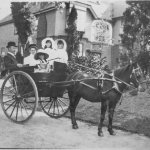your family stories
World War 1 and Montreal
Montreal in 1914
The British immigrants living in Montreal at the outbreak of World War 1 were largely staunch supporters of the British Empire as were other British-born Canadians elsewhere in the Dominion of Canada. These British-born immigrants would be quick to volunteer to fight when war was declared in August, 1914. Those who couldn't fight would support their soldiers from the home front. They were ready to sacrifice for the cause.
Montreal in 1914 was:
… the richest and most populous city in the Dominion, the headquarters of many financial and commercial institutions with Dominion-wide ramifications, the home of many of the shrewdest and most far-sighted of Canada’s business men…Where it leads, others tend to follow. -Philip H. Morris, "The Canadian Patriotic Fund"
Build-up to World War 1
Britain had agreed in 1907 to support the French if it came to war with Germany. The British had become uncomfortable with the growth of Germany’s Navy and had brought their ships back from the Mediterranean to defend the English Channel. Meanwhile, after 1907, military training, organization and equipment had been standardized throughout Britain’s colonies.
By 1909, most Canadian provinces, including Quebec, had started cadet training in the schools.
Leading up to outbreak of World War 1, the Minister of Militia (1911-1916), Colonel Sam Hughes, had been working at preparing the populace in the event of war. He foresaw the eventuality of a war with Germany.
In 1913, 55,000 militia men and 44,000 cadets drilled in militia camps. Valcartier camp, a site 20 miles north of Quebec City, had been designated a future militia camp early in 1914.
On July 29th, 1914, Canada received a warning from Britain to take precautions in case of a surprise attack. Armed militia men were posted to guard tunnels, bridges, canals and railway stations.(Morton & Granatstein, 1989)
War Declared
When Britain declared war on Germany August 4th, 1914, thousands of men were ready and willing to offer their lives as soldiers of the Empire. From Montreal, just one of two battalions, The Royal Highlanders of Canada, headed to Valcartier on August 24th with 1,017 soldiers.
British Reservists
Immediately after the war that would be known as World War 1 was declared, some 10,000 British reservists living in Canada prepared themselves to return to Britain. Thousands more from France and Belgium headed home to defend their countries against the German invasion. (Morris, not known)
Canadian Patriotic Fund:
With the reservists heading back to the home countries, it became immediately apparent that any dependants they left behind would be in need. Within two weeks, a Montreal M.P., Herbert Brown Ames, was promoting The Montreal Patriotic Fund, an association intended to raise money for the care and support of these dependants. He petitioned the Governor-General of Canada, His Royal Highness, The Duke of Connaught, to create a national fund for this purpose: The Canadian Patriotic Fund. One centralized organization would provide a uniform system for collecting voluntary contributions from the populace and determining who would be eligible for support. By September 1st, the Canadian Patriotic Fund was in operation based in Ottawa. (Morris, not known)
British-born soldiers:
Of the first 30,000 who joined up, two-thirds were British-born immigrants. These soldiers of the first Division sent over in October, 1914, came mostly from three cities: Toronto, Winnipeg and Montreal. Each city sent two full regiments. Montreal contributed the 13th and 14th Battalions, two of four battalions in the 3rd Brigade.
Montreal Battalions who served in WW1:
The 13th Battalion – Royal Highlanders of Canada (The Black Watch), 3rd Brigade, Division 1.
(A history of this battalion from 1914-1919 can be found here on archive.org).
- George Ernest Blackwell, b. Mtl, Qc, Nov. 18, 1893 (Parents b. Eng.)
The 14th Battalion – Royal Montreal Regiment , 3rd Brigade, Division 1.
- Herbert Edward Shill, b. Ufford, Suffolk, Dec. 30, 1894
The 24th Battalion was formed in March 1915 and became part of the 5th Brigade, Division 2.
The 42nd Battalion was formed in July 1915 and became part of the 7th Brigade, Division 3.
The 60th Battalion was formed in August 1915 and became part of the 9th Brigade, Division 3.
The 73rd Battalion was also formed August 1915 and became part of the 12th Brigade, Division 4.
(Source: http://battlefields1418.50megs.com/cef_battalions.htm)
Valcartier, Quebec
During the month of August, 1914, the camp at Valcartier was set up to receive the soldiers, horses and equipment which were assembled there before departing Quebec City on 30 ships on October 3rd. With 6,000 more soldiers than originally planned, a 31st ship was quickly called into service and left October 4th, 1914.
The Home Front 1914-1918
Volunteerism – with many men gone and the special needs of a country at war, most people wanted to “do their bit” .
“Give til it hurts” – The Canadian Patriiotic Fund depended on the populace to fund their charity. People were told that if they couldn’t fight, they could pay.
Local Militia – Some men were needed on the home front to protect the country. If you weren’t quite fit for overseas duty, you might be suitable for tasks at home.
Opportunity for women – The needs for volunteers and shortage of workers opened the doors for new experiences for women. Certainly, to not have their husbands questioning their movements, women would be freer to do what they saw fit. Additionally, as in Nell Shill’s case, the income from the soldier who was away could fund schooling for a girl who otherwise wouldn’t be able to afford it.
Canadian Immigration and World War 1
Immigration during the war years, 1914-1918, decreased dramatically from its height immediately before. Throughout the war, not only did the total number of immigrants decrease, the percentage of British immigrants became minimal. After the end of the war, between 1919 and 1924, immigration again increased and the percentage of immigrants from Britain varied between 48% and 56% of the total.
| Year | Total Immigrants |
Total British |
% British |
|---|---|---|---|
| 1912 | 375,756 |
147,619 |
39 |
| 1913 | 400,870 |
158,398 |
39 |
| 1914 | 150,484 |
50,755 |
33 |
| 1915 | 36,665 |
9,907 |
27 |
| 1916 | 55,914 |
10,140 |
18 |
| 1917 | 72,910 |
4,114 |
5 |
| 1918 | 41,845 |
5,396 |
12 |
| 1919 | 107,698 |
57,929 |
53 |
| 1920 | 138,824 |
77,160 |
55 |
| 1921 | 91,728 |
44,367 |
48 |
| 1922 | 64,224 |
32,604 |
50 |
| 1923 | 133,729 |
75,501 |
56 |
| 1924 | 124,164 |
59,680 |
48 |
| 1925 | 84,907 |
35,457 |
41 |
Imperial Army Soldiers
Some British immigrants after demobilization were soldiers who had fought for the Imperial Army during World War 1. Many of them came looking for adventures and opportunities in Canada.
Jim (James Verner) Waddell was an Imperial Army Veteran who moved to Montreal after the war.
World War 1 Veterans:
Those soldiers who survived World War 1 knew better than anyone what it had taken to achieve peace. They were proud to take part in Remembrance Day Celebrations.
Vimy Pilgrimage
The Canadian Legion organized a pilgrimage to attend the unveiling of the Vimy Memorial which took place on July 26th, 1936. Jim Waddell of Montreal was one of 8,000 Canadians who attended and cherished the memorabilia from this event.
Bibliography
Duguide, A. (1938). Official History of the Canadian Forces in The Great War 1914-1919 General Series Vol I. Chronology, Appendices and Maps. Ottawa: Minister of National Defence.
Morris, P. H. (not known). Canadian Patriotic Fund; World War, 1914-1918 - Relief Measures. No Publisher.
Morton, D., & Granatstein, J. (1989). Marching to Armageddon: Canadians and the Great War 1914-1919. Toronto, Canada: Lester & Orpen Dennys Limited.
Return from World War 1 and Montreal to Home Page
Go to No. 25637 Cpl H.E. Shill's Military Service Record


